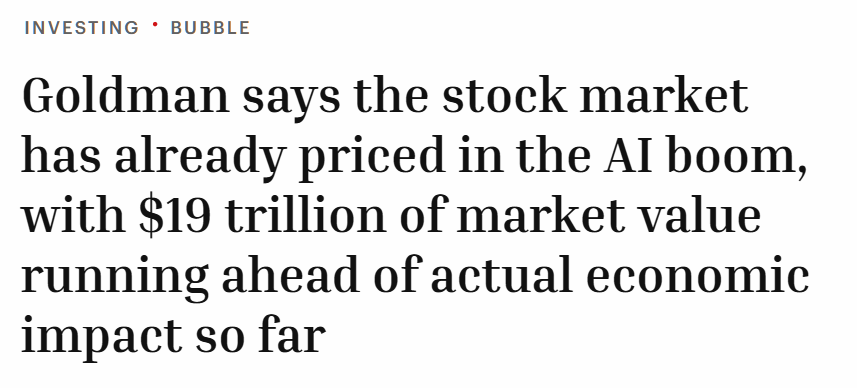Good morning, traders…
One question has been dominating social media, financial news, and trading forums for the past month:
“Are we in an AI bubble?”

Since the release of ChatGPT in November 2022, AI has been the biggest buzzword in the stock market.
The potential of the technology is enormous. Every tech company wants to get in on the ground floor.
The race to AI supremacy has made Nvidia Corporation (NASDAQ: NVDA) the most valuable company in the world (and doubled the Nasdaq in the process).
But recently, the overwhelming enthusiasm has tempered into a cynical bearishness that’s impossible to ignore.
Several high-profile institutions, investors, and analysts have begun sounding the alarm, warning market participants of an impending correction:




These statements, coupled with the government shutdown’s “liquidity desert,” have been a major contributor to the recent choppy market conditions.
When dozens of legendary market figures all say the same thing, you can’t ignore it.
But you can’t take it as gospel, either.
So how do we answer the “bubble question?”
We don’t have a crystal ball.
But we do have a lot of evidence…
The Case For the AI Bubble
40% of the Market Is In “AI Stocks”
Over the past 3 years, the stock market’s strength has been packed into a small handful of mega-cap tech firms.
The Magnificent 7 (Nvidia, Apple, Microsoft, Alphabet, Meta, Amazon, and Tesla) now make up nearly 40% of the S&P 500’s total market cap.
That’s a level of concentration not seen since the 2000 dot-com bubble … right before it burst.
A major correction in AI stocks would crash the major indexes (simply due to their construction).
Playing Hot Potato With The Money
The hyperscalers are effectively passing the same pile of money around.
Oracle’s stock spiked after reporting a huge data-center rental deal with OpenAI, which raised billions from Nvidia (the same company supplying Oracle with GPUs).
These companies all invest in AI startups that end up spending that capital right back on the same companies’ infrastructure.
Just yesterday, Nvidia and Microsoft invested $10 billion and $5 billion (respectively) in Anthropic.
The result is a closed financial loop that reinforces valuations without necessarily reflecting sustainable profits.
AI Itself Isn’t Making Money Yet
While the hype continues, the underlying economics of AI as a business are weak.
Training large AI models is extraordinarily expensive without much profit to show for it … yet.
Nvidia is the winner from selling the GPUs.
Meanwhile, the companies actually building AI appear increasingly desperate to show any form of revenue, echoing the late-stage behavior of prior bubbles (where businesses stretched the narrative to justify valuations).
Fragile Expectations Could Exaggerate Downside
Share prices across the tech sector are inflated by the assumption that AI will eventually add trillions to global GDP.
If those productivity gains fail to materialize, the entire story will unwind.
The Case Against the AI Bubble
It’s Funded by Cash, Not Debt
Unlike the dot-com and housing bubbles, today’s AI build-out isn’t fueled by cheap credit or speculative borrowing.
Over the past two decades, U.S. tech giants have quietly amassed trillions of dollars in cash reserves. Far more than any other sector.
Before 2017, tax laws encouraged moving profits offshore (usually to Ireland).
But once the 2017 tax reform allowed repatriation at lower rates, those funds became ripe for U.S. investments.
That’s the dry powder now being deployed into AI. So, while it may look speculative, it’s being funded by an enormous pile of savings (with plenty of cash left in it).
They’re Making Up for the “Lost Decade”
Those massive profits we just talked about?
For most of the 2010s, Big Tech had few worthwhile ways to invest them.
Dominant market positions made new R&D or product expansion appear unnecessary.
AI finally presents a genuine frontier. A high-risk, high-reward opportunity that justifies large-scale capital spending after years of corporate stagnation.
The spending spree is a long-delayed catch-up rather than reckless excess.
This “Bubble” Has Already Weathered Storms
Past bubbles burst under external stress.
The dot-com crash followed Microsoft’s antitrust case, MicroStrategy’s accounting scandal, and a single article exposing unprofitable internet startups.
The housing crash began when subprime loans reset and lenders went bankrupt.
By contrast, AI investments have already weathered multiple potential shocks: tariffs, regulatory scrutiny, rising rates, and public skepticism.
Yet valuations remain intact. That durability suggests stronger underpinnings than earlier manias.
It’s A Geopolitical Necessity
Massive AI investment is a geopolitical strategy.
The U.S. views AI dominance as a national security and economic priority.
President Trump has said:
- “Winning the AI race will usher in a new golden age of human flourishing, economic competitiveness, and national security for the American people.”
- “From this day forward, it’ll be a policy of the United States to do whatever it takes to lead the world in artificial intelligence.”
Even if near-term profits lag, the long-term geopolitical payoff makes these investments rational from a strategic standpoint.
It’s An Asymmetric Bet
Tech leaders openly admit they can’t predict exactly where AI will lead, but the economics are asymmetrical.
They’re betting roughly $500 billion for a potential $10 trillion return in productivity and market dominance.
Risky? Yes. But it’s backed by enormous cash reserves, diversified businesses, and government support.
It takes the sting off knowing the government will probably comp them some chips if they keep the game going.
My Thoughts on the “AI Bubble”
While some tech stocks may be overvalued…
I don’t believe we’re in a massive AI bubble.
This isn’t like the dot-com era. Today’s tech giants have fortress balance sheets.
They’re not running out of money any time soon, even if they keep spending.
I think some folks call it a “bubble” because they don’t know what else to call it.
Zoom out. Look at the big picture.
We’ve run 35% from April lows.
Were the indexes overextended a month ago? Due for this pullback?
Yes.
Will it be a 20% correction?
Unlikely.
That will only happen if another negative catalyst accompanies it.
Examples:
- An unexpected Trump tariff move.
- Weaker-than-expected Nvidia earnings.
- A geopolitical black swan.
I struggle to agree that AI is the problem.
But we’re going to get a big part of that answer during Nvidia’s earnings call this afternoon.
If Nvidia’s earnings growth shows any signs of slowing down, that will add fuel to the bubble story.
If they crush estimates again, expect the “bubble talk” to quickly evaporate.
From where I’m sitting, the recent volatility comes down to one thing: the natural fluctuations of the market.
My prediction?
When the government fully reopens and quantitative easing resumes, up goes the stock market.
That’s why I’m staying patient during this chop.
I’m waiting for the major indexes to re-enter a reliable uptrend before making any big moves.
But if you aren’t already preparing for the potential reversal, you’ll miss it.
How do you think I bagged recent gains like:
- +159% in 2 days on MRK*
- +49% in 1 day on GOOGL*
- +64% in 2 days on EOSE*
- +244% in 1 day on PYPL*
Knowing when to enter is Step 1.
But position sizing, scaling out, and protecting gains are just as crucial.
We’re about to cover all of this (and more) in my 2-Day Simpler Options Bootcamp…

*Past performance does not indicate future results


